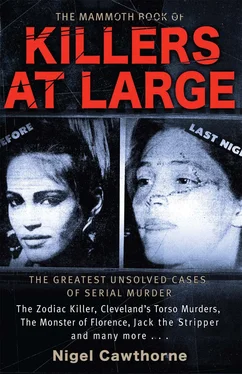Before dawn the following day, the police discovered the body of 17-year-old Kseniya Medintsevaya dumped in the courtyard of a kindergarten. Her face was smeared with blood and her dress was ripped open. Again she had been raped, beaten and strangled. She had last been seen alive at 11 p.m. in her apartment the previous night.
On 4 July, the naked body of 28-year-old Irena Gera was found several miles from the centre of Moscow where she lived. She had been raped and strangled with the strap of her handbag.
The next victim was a 25-year-old Ukrainian prostitute named Alexandra. She was found strangled in her apartment on 8 July. One end of a belt was tied around her neck. The other was attached to a door handle.
Near Alexandra’s apartment, the police found the partially clothed body of 32-year-old teacher Elena Tolokonnikova on 11 July. Last seen out with friends the night before, she had not returned home.
Then on 15 July, the decomposing body of a woman was found near a pond. The remains were not identified. However there were signs of the handiwork of the same killer. Like the other victims, she was short, slim, with a fair complexion and long, light-coloured hair.
The seventh victim was 17-year-old student Tatyana Nikishina. She was killed on 21 July. Her assailant had tried to rape her. Then he strangled her with her bra and left her body in the northwest of the city. Police did not release the names of the other three victims slain that night. However, the killer seems to have begun to adopted a variety of methods. One was bludgeoned as well as strangled, another purely bludgeoned, hit by a blunt object from behind, and the third was killed having her head smashed against concrete. The youngest victim was 17; the oldest 35.
Moscow police have organized a task force to investigate the murders, but did not, at first, admit a serial killer was at work, due to the various methods of strangulation and bludgeoning he had employed. Some victims were strangled with ligatures, others manually. Some were beaten; some sexually assaulted. Seven of the ten victims were found in the northern section of the city, but the other three were killed several miles away in the northeast. There was no single MO.
At least six were well educated. One, Alexandra the Ukrainian prostitute, was not. She was the only one to be found indoors. She had been soliciting in a nearby market that day and could have picked up what she thought was a client, or she might have been followed home. There were other inconsistencies. Yulia Bondareva, the first known victim, was attacked and killed in a public park in broad daylight, while the others were killed at night. Why had Irena Gera travelled from her home to the city’s northern section where she was attacked and murdered? And why did Kseniya Medintsevaya leave her apartment in the middle of the night?
Russian Interior Minister Boris Gryzlov said that the ten women were killed by different assailants, claiming that three men had already been arrested. And a senior police official characterized the bunching of murders as “coincidence”.
Then on 23 July, a man stepped from a wooded area and grabbed a female pedestrian by the throat. He pulled her to the ground and dragged her into the bushes. A woman looking out of the window of an apartment opposite called the police, who caught the man. He was an immediate suspect in Moscow’s string of unsolved murders. However, he was soon dismissed as a copycat. On 28 July, while he was in custody, the body of a 42-year-old woman was found in a schoolyard northwest of the city. She had been raped and strangled. As in the case of 17-yearold Kseniya Medintsevaya, she had been dumped outside a kindergarten. A pattern appeared to be emerging.
Investigators found three victims who had survived similar attacks. In each case the assailant had concealed himself in bushes or behind a fence, then sprang out on the unsuspecting victim as she walked past. They also provided detailed descriptions of their assailant. He was a white male with short hair, a thin face, small eyes, bushy eyebrows, a large nose and thick lips. Aged between 35 and 40, he was between five foot seven and five foot nine, and wore jeans and a dark T-shirt.
These details were never released to frightened Muscovites, who drew their own conclusions. Women remained indoors while the men were sent out to do errands. They knew that, if a serial killer was at work, he was killing at a terrifying rate. But he could not be found.
Then in mid-June, the body of a woman was found in Bitsa Park in the south of the city. The following day, her work colleague at a small grocery store in southwestern Moscow Alexander Pichushkin was arrested. A loader there, he confessed to killing the woman and said that he had planned to kill as many as 64 people.
In all Pichushkin has so far confessed to killing 62 people, beginning in 2000, but investigators say they do not have sufficient proof to believe everything he says. However, prosecutors charged him with 49 counts of murder on 14 December 2006. There are questions about his sanity and the killings in the north of the city were far from his usual patch, opening the possibility that a second killer is at large there.
Scotland—Glasgow’s Bible John
Bible John was the nickname given to a killer who murdered three women in Glasgow in the 1960s. He has never been caught or identified and as late as December 2004 the Scottish police were still actively investigating the case.
On the evening of 22 February 1968, Patricia Docker decided that she needed a night out. Her husband, a corporal in the RAF, was stationed in England, leaving the 25-year-old nurse and her young son lodged with her parents. It was a Thursday night and they were happy to babysit the toddler.
Patricia got dressed up for the occasion and it seems she went to a number of ballrooms that evening. She was seen at the Majestic, then moved on to Barrowland Ballroom. This was popular with her friends as, on a Thursday night, it catered to those aged 25 and over. It was busy. Patricia did not particularly stand out and it was difficult to identify all her dance partners. However, it seems that someone offered to walk her home. She never got there.
At dawn the following morning, a cabinet maker on his way to work found the naked body of a dead woman in a quiet lane a few yards from the Dockers’ house. She had been strangled with her own tights, but none of her other clothing could be found. The police determined that she had been dead for several hours. They came to believe that she had been strangled elsewhere and dumped there. When they heard that Patricia Docker had not returned home, the police came to the obvious conclusion and Patricia’s parents had the gruesome task of identifying the body.
In an attempt to find some clue to identify the killer, the police widened their search for Patricia’s clothes, handbag and other belongings. Divers even searched the river nearby, but nothing was found. One local resident told the police that she thought she had heard cries for help during the early hours of 23 February, but none of the journalist and photographers who had attended a colleague’s party near where the body was found that night remember anything. A photograph of a policewoman dressed in clothes similar to those Patricia was wearing that night was circulated in the area, but no one remembered seeing her after she left the dancehall.
Glasgow had had recent experience of serial killers. Ian Brady, who was convicted of the Moors Murders in 1966, had been born there. Ten years before Patricia Docker was killed, Peter Manuel became one of the last people to be hanged in Scotland. A sociopath and burglar, he had killed at least eight people around the city. So when Patricia’s naked body was found dumped in the street, Glaswegians feared the worst. But that did not stop them having fun.
Читать дальше











